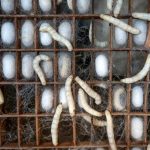Have you ever considered the untapped potential of seaweed in fashion? Algae-based textiles are emerging as a game changer in eco-friendly fashion, offering sustainable alternatives to traditional fabrics. With their rapid growth and unique properties, these textiles could shift industry standards. But what exactly makes them so compelling, and how might they reshape your wardrobe choices? Let’s explore the innovative processes and benefits behind this intriguing material.
Table of Contents
Key Takeaways
- Algae-based textiles utilize renewable resources, promoting sustainability and reducing the environmental impact of fashion production.
- Seaweed fabrics grow rapidly, require minimal water, and do not need fertilizers or pesticides, making them eco-friendly alternatives.
- The unique properties of algae fibers enhance textile performance, offering natural anti-bacterial benefits and innovative design potential.
- Innovations in processing and manufacturing techniques, such as enzymatic processing and 3D printing, support a circular economy in fashion.
- Increasing consumer demand for sustainable options and collaborations in the industry signal a promising future for algae-based textiles.
The Benefits of Algae Cultivation for Textile Production
Algae cultivation offers several advantages for textile production, especially as sustainability becomes a priority in the fashion industry. By harnessing algae, you tap into a renewable resource that requires minimal land and water, reducing the environmental footprint of your textile production.
Algae can grow quickly and absorb carbon dioxide, helping combat climate change while providing natural dyes and fibers for your fabrics. Additionally, using algae can enhance the performance of textiles, giving them unique properties like moisture-wicking and UV resistance.
You’ll also find that algae-based textiles can appeal to eco-conscious consumers, boosting your brand’s image in a competitive market. Embracing algae cultivation, you join a movement towards innovative, sustainable fashion solutions that benefit both the planet and your business.
Innovative Processes in Algae Textile Manufacturing
As the demand for sustainable materials grows, innovative processes in algae textile manufacturing are emerging to reshape the industry.
You might be surprised to learn how algae can be converted into fibers using techniques like enzymatic processing and spinning. These methods extract cellulose from seaweed, creating a biodegradable and renewable source for textiles.
Additionally, advancements in 3D printing technology allow for customized designs, reducing waste and promoting efficiency. Companies are experimenting with blending algae fibers with traditional materials, enhancing performance while maintaining eco-friendliness.
By embracing these innovative processes, you’re not just contributing to eco-fashion; you’re also supporting a circular economy.
As these techniques advance, you’ll see a broader range of sustainable clothing options hitting the market.
Sustainable Attributes of Seaweed Fabrics
While exploring sustainable fashion, you’ll discover that seaweed fabrics offer remarkable environmental benefits.
These textiles are made from renewable resources, as seaweed grows rapidly without the need for fertilizers or pesticides. Unlike conventional cotton, seaweed cultivation doesn’t require large amounts of freshwater, making it a more eco-friendly option.
Seaweed fabrics also possess natural anti-bacterial properties, reducing the need for chemical treatments during production.
Seaweed fabrics offer natural anti-bacterial properties, minimizing the reliance on harmful chemical treatments in their production.
Plus, they’re biodegradable, meaning they’ll break down naturally at the end of their life cycle, minimizing waste in landfills.
You’ll appreciate the comfort and unique textures of these materials, which can provide a stylish alternative to synthetic fabrics.
The Role of Algae in Eco-Friendly Fashion
In the quest for sustainable fashion, incorporating algae into textiles has emerged as a game changer. You’re probably aware that traditional fabric production can be resource-intensive, but algae offers a revitalizing alternative.
These marine plants grow rapidly, require minimal resources, and absorb carbon dioxide, making them an eco-friendly choice. When you wear algae-based fabrics, you’re not just making a style statement; you’re actively supporting a more sustainable industry.
Algae fibers can be blended with other materials to enhance durability and comfort, giving you fashionable yet environmentally responsible options. Plus, the unique properties of algae can lead to innovations in texture and design.
Future Prospects for Algae-Based Textiles in the Market
The future of algae-based textiles in the market looks promising, driven by a growing demand for sustainable fashion solutions.
As consumers become more eco-conscious, brands are increasingly looking to incorporate innovative materials like algae into their products. You’ll see a rise in collaborations between fashion designers and biotech companies, creating unique textiles that not only reduce environmental impact but also offer exciting designs.
Additionally, advancements in production processes will likely lower costs, making algae-based fabrics more accessible to both companies and consumers.
As sustainability becomes a priority, you can expect to find these materials in mainstream fashion, reshaping how you think about clothing and its ecological footprint.
Embrace this eco-fashion revolution, and consider supporting brands that prioritize algae-based textiles.
Frequently Asked Questions
How Does Algae Cultivation Impact Local Ecosystems?
Algae cultivation can enhance local ecosystems by improving water quality and providing habitats for marine life. However, if overdone, it may disrupt natural balance, leading to oxygen depletion and harming native species. Balance is key.
What Are the Main Challenges in Algae Textile Production?
Creating algae textiles can feel like steering through a maze; you’ll face challenges like inconsistent quality, scalability issues, and limited consumer awareness. Overcoming these hurdles is essential for making sustainable fashion a reality.
Can Algae Textiles Be Recycled or Composted?
Yes, algae textiles can be recycled or composted. You’ll find they break down naturally, making them an eco-friendly choice. Just guarantee you follow proper disposal methods to maximize their environmental benefits.
How Do Algae Fabrics Compare to Cotton and Polyester?
When comparing fabrics, you’ll find algae offers a unique charm over cotton and polyester. It’s lightweight, biodegradable, and often requires less water, making it an appealing choice for those seeking sustainable alternatives in their wardrobe.
What Certifications Exist for Sustainable Algae Textiles?
You’ll find various certifications for sustainable algae textiles, such as Global Organic Textile Standard (GOTS) and OEKO-TEX. These guarantee the materials meet environmental and social criteria, promoting transparency and ethical production in the fashion industry.



